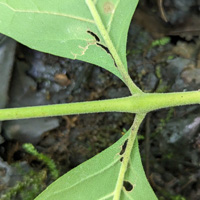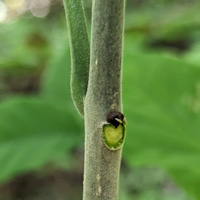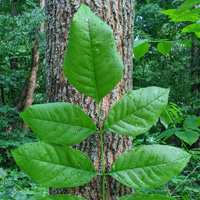Pumpkin Ash
Scientific name: Fraxinus profunda



Photo credit: Will Van Hemessen (left and centre), Pat Deacon (right)
Status
Endangered
“Endangered” means the species lives in the wild in Ontario but is facing imminent extinction or extirpation.
Date added to the Species at Risk in Ontario List
January 29, 2024
Read the assessment report (PDF)
What it looks like
Pumpkin Ash is a medium-sized deciduous hardwood tree that can grow 15 to 30 m in height and up to 173 cm in diameter.
It has broad, opposite, pinnately-compound leaves that are 20 to 45 cm long with 5 to 9 leaflets. The bottom surface of leaflets and occasionally the veins have dense, fine, short hairs. The bark is light grey brown in colour with interlocking edges. Young tree bark has small grooves and mature tree bark has deep grooves.
Pumpkin Ash flowers are small, green and purple in colour, and grow in clusters. The flowers appear between late April and mid-May, usually at the same time as the leaves. Like other ash species, the fruit is winged, single-seeded and found in clusters.
Pumpkin Ash has the largest seed of the native ash species averaging 6.1 to 7.1 cm in length and 9 mm in width. Seeds mature in late summer and fall from the tree between October and December.
Where it lives
Pumpkin Ash is native to eastern North America from Florida to Southern Ontario. In Canada, Pumpkin Ash is only found in Ontario.
Pumpkin Ash grows in swamps, wet floodplain forests and, occasionally, in coastal swamps. In Canada, Pumpkin Ash grows in swamps alongside Silver Maple and in floodplain forests.
Where it’s been found in Ontario
Pumpkin Ash is only found in southwestern Ontario, where only two mature Pumpkin Ash are known and fewer than 10 are expected to remain in Canada.
It is estimated the number of mature Pumpkin Ash has recently declined by over 90% due to the impacts of the invasive Emerald Ash Borer. Over 400 known seedlings and saplings are also at continued risk from Emerald Ash Borer.
Pumpkin Ash was previously reported in the following locations:
- County of Elgin
- County of Essex
- County of Lambton
- County of Norfolk
- County of Middlesex
- Municipality of Chatham-Kent
- Regional Municipality of Niagara
The remaining members of the species occur in the County of Norfolk.
What threatens it
Like most ash species in Canada, the direct threat to Pumpkin Ash is the Emerald Ash Borer.
Other threats include:
- land conversion to agriculture
- roads and utilities
- logging and wood harvesting
- recreational activities
- climate change
- deer-browsing
- changes to ecosystems by non-native plant species
Action we are taking
This species and its habitat are protected under Ontario’s Endangered Species Act, 2007 (ESA).
The ESA also requires us to prepare recovery guidance for endangered species such as Pumpkin Ash to guide recovery efforts for the species in Ontario.
All species listed on the Species at Risk in Ontario List may be eligible for consideration for government funding through the Species at Risk Stewardship Program.
What you can do
Report a sighting
Submit your observations of species at risk to the Natural Heritage Information Centre (NHIC), which is Ontario’s conservation data centre. Join the “(NHIC) Rare Species of Ontario” project in iNaturalist to make submitting your observations quick and easy.
Volunteer
Volunteer with species at risk programs, such as community science surveys, through your local nature club, a provincial park or other conservation organizations.
Be a good steward
- Private landowners have a very important role to play in species recovery. If you find species at risk on your land, you may be eligible for stewardship programs that support the protection and recovery of species at risk and their habitats. Learn more about the Species at Risk Stewardship Program.
- Invasive species seriously threaten many of Ontario’s species at risk. To learn what you can do to help reduce the threat of invasive species, visit:
- As with all wildlife, be respectful and observe from a distance.
Report illegal activity
Report any illegal activity related to species at risk to
Quick facts
- Pumpkin Ash gets its common name from the bases of mature trees, which tend to swell in wet habitats, resembling pumpkins.
- Pumpkin Ash closely resembles Green Ash and because of this, was overlooked until 1992 when it was first discovered in the County of Essex.
- Pumpkin Ash has the largest winged fruit and seeds (samara) of any ash species, growing up to 8 cm long.
- Pumpkin Ash samaras are a food source for many birds and mammals, including: squirrels, chipmunks, wild turkey, wood ducks, chickadees.
- Pumpkin Ash only occurs in the Great Lakes Plains area.